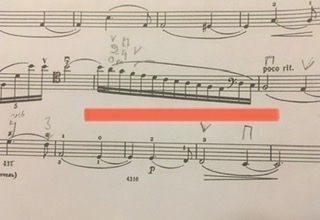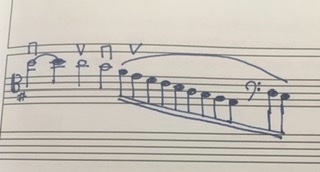Welcome to our forum. A Message To Our New and Prospective Members . Check out our Forum Rules. Lets keep this forum an enjoyable place to visit.
Currently working on errors from the latest (SimplePress) forum update. Many issues have been resoled and others are being worked on. Thank you for your patience.
 Topic RSS
Topic RSS



 (4 votes)
(4 votes) Regulars
 Offline
Offline






I'm posting this to cello thread, but I think the problem is same for all stringplayers, so feel free to join in!
So the question is how do you practice very long slurs? Do you break them down first? Into 2 or 4-note groups?
In this picture is an example what I'm practicing just now, and this is almost driving me crazy. It runs from A to G- string, so it’s not enough that my left hand knows what to do when I need to cope with string changes as well... I have succeeded couple of times but I think I did it just accidentally. 😂
I think I'm going to try practice it with different rhytms next, it might help...🤔

Regulars







I do something similar, except that I start with groups of notes because it's hard to tell how much of the bow is being used with one note at a time but much easier to tell with somewhat longer slurs.
Depending on the length of the slur, I divide it either in half or in quarters, so each short stroke is either one-half or one-quarter of the length of the full slur and I can check whether I am that far along the bow. I go shorter if I feel it is necessary at that point.
Regulars
 Offline
Offline






AndrewH said
I start with groups of notes because it's hard to tell how much of the bow is being used with one note at a time but much easier to tell with somewhat longer slurs.
Thank you @AndrewH, that makes sense! I will try this!
Regulars
 Offline
Offline





Well, you have there 14 notes to play in a 3/4 measure. I don't know how fast, but I suspect fast enough for it not to be about rhythms but rather about timing an even "flurry" and ending on the right note, B, at the right time. So just practise the scale evenly so that your left hand fingers know where they're going, getting faster and faster, then practise it against a metronome or just tapping your foot, aiming for the B on the fourth beat, like archery.
OK, the question is about long slurs. Their usual problem is bowing too fast at the beginning and running out of bow. But if that run is fast enough, that shouldn't matter. Otherwise, try bowing slowly.
Andrew
Verified human - the ignominy!
Regulars
 Offline
Offline






Yes, my problem is exactly that I’m easily running out of bow. I’m using it too much for the first notes and then I don’t have enough room usually for the last two notes... I have to do something for that.
Regulars
 Offline
Offline





Regulars
 Offline
Offline








@Ilona -
Wow! I thought it was bad that I had a run of 9 notes in "King George IV Strathspey" and long runs in "The Rights of Man Hornpipe", but they're actually written as 4 note groupings (not one like yours)!
You've got 14! AND your fingers have to stretch - mine don't!
I have to agree with AndrewH - we only have 4 fingers, so you have to play groups of notes, but practiced to the point of seamlessly.
Might help if you can get a rhythm in your head - can you hear how it should sound, played by someone else? That helped me.
Can't wait to hear how you solve this problem!

- Emily
Regulars







Eventually the goal is to try to think of the hands separately from one another. The bow stroke is going to last three beats. The fingers need to land on the low A at the beginning of the next measure. Of course, it's tempting to accelerate the bow because the notes are moving so quickly and you are moving across strings, which is why it's a good idea to practice bow distribution with smaller groups of notes as suggested before. But there's another possible approach: practice the right hand alone (on the appropriate strings) until you are secure in going the length of the bow in exactly three beats, and then add the left hand.
Regulars
 Offline
Offline






Ok, here is my super stylish drawing of how my teacher said I should do this slur. So finally only 11 notes. 😂
It starts from F# and E in 4th position, then quick shift to 1st position and after that the rest is easy. Well, I can do this now but I don’t say it’s easy... 🤭
I practised it only on the A-string first so that I got that shift to work quickly. I also played this back and forth to make sure my fingers knew where to go. I still need more speed, but my teacher said I can choose the tempo myself, because when playing with accompanist this part is without the piano.

Regulars
 Offline
Offline








Regulars











Ilona, you write out music really well! My attempts never look that good. Glad you’ve got a solution that works for you. Playing a string instrument reminds me to be flexible.
There was a time when I’d be trying to play something as written (e.g., fingering). Then, after being frustrated for a while, my teacher would say something like, “Well, you could try something like this…” I would respond by saying “But that’s not what’s written there.” Like the music police were going to show up and give me a fine for breaking the violin fingering law.
I think about alternatives all the time now—part of the process.
Characterize people by their actions and you will never be fooled by their words.
Regulars
 Offline
Offline






SharonC said
There was a time when I’d be trying to play something as written (e.g., fingering). Then, after being frustrated for a while, my teacher would say something like, “Well, you could try something like this…” I would respond by saying “But that’s not what’s written there.” Like the music police were going to show up and give me a fine for breaking the violin fingering law.
Yes, I recognice that! I sometimes strongly disagree with fingerings written to some pieces. When I started to play I couldn’t think they are not always the only truth, but nowadays when I can use all the neck positions fluently I can also do my own decisions better.
I just started to practice Lied ohne Worte by Mendelssohn, and there is some passages where I really need to think if that’s the best way to play it what’s written there.
1 Guest(s)


 Log In
Log In Register
Register












